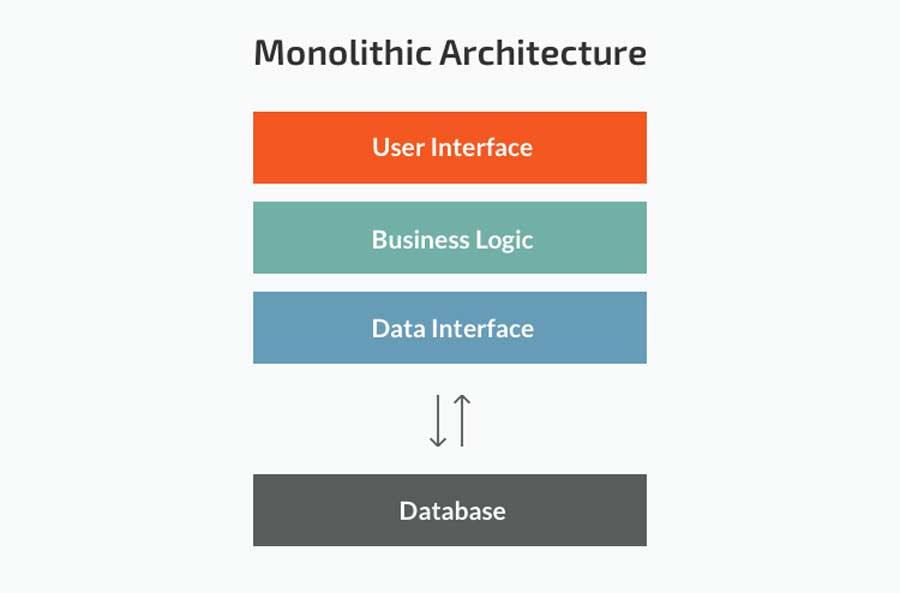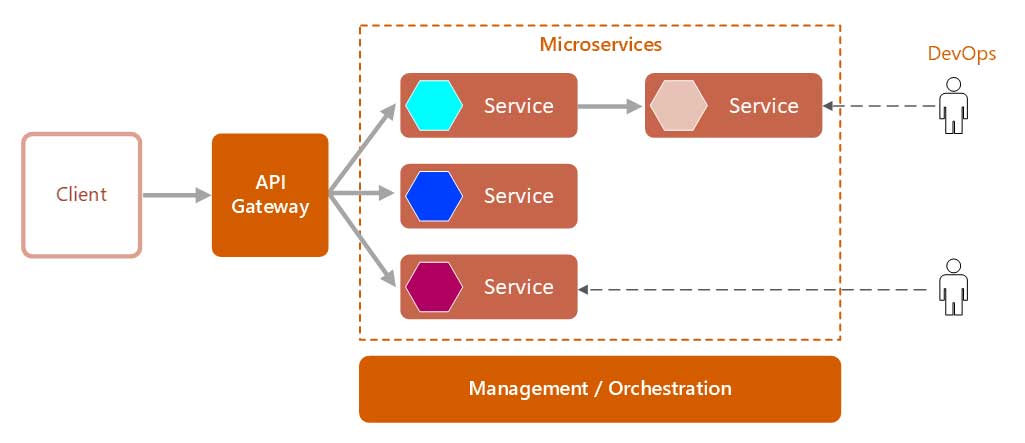Microservices Architecture: How It Works and Why to Use It
Traditional web architectures are no longer suitable for large and complex business systems. In this article, you’ll learn how to implement a microservices architecture for better flexibility and performance
As the internet and businesses have evolved over the years, web systems have become more and more complex. And as they’ve grown larger, web services have faced issues with flexibility and maintenance. In response, engineers have needed to come up with more effective, flexible architectures.
Today, the microservices architecture is one of the best web development patterns, allowing you to avoid most of the downsides of monolithic web development.
The idea to divide software into microservices appeared back in the 70s, but only now has it become widespread due to technologies like cloud computing, DevOps, containerization, and modern lightweight programming languages such as Swift, JavaScript, Python, and Rust.
A demand for fast and dynamic changes in business products was the cause of the waterfall development model being almost completely replaced by Agile. Nowadays, software has to be flexible to respond to the ever-changing market demands.
The old monolithic approach to web development isn’t working for various reasons. In this article we’ll talk about the microservices software architecture patterns and techniques, and discuss why microservices architecture be beneficial for certain software products.
Disadvantages of monolithic web architectures
We’re all used to a classic web architecture that consists of three main layers: presentation, business, and database. The presentation layer shows content to the user and allows them to interact with the software, the business layer is responsible for the application’s business logic, and the database layer receives and responds to requests from the business layer.
In the system of microservices architecture components, every function is connected with another. So if you change just one thing in a monolithic web app, you need to make sure you haven’t broken anything else. Such systems often suffer from:
- Spaghetti code
- Scalability issues
- Lack of structure
- Technical debt
- Maintainability issues
- Integration issues
Scalability
Monolithic applications have to be scaled and maintained equally in all their parts, which is so difficult and expensive that businesses often choose quick solutions that are harmful in the long run but fix the business problem right now.
Integrations with monolithic applications are also very complex. Monolithic systems are created in a single tech stack and written in one programming language. This means you won’t be able to integrate modules written in other languages, or at least it will be difficult.

Maintainability
Because businesses often depend on software (for example, for management, order processing, payments, and so on), businesses have no time to put the whole system on hold until it’s finally fixed.
It’s hard to maintain a monolithic system, as all of its parts are interconnected. This makes it difficult to fix a certain part of the code or get rid of it without the risk of breaking other parts of the system.
Flexibility
Modern business software needs to be highly flexible because market trends, best practices, and expectations change constantly and new technologies emerge every year. Businesses need to shorten their time to market and release hot new features as soon as possible. Doing so in a monolithic system is hard, since systems that support only a certain tech stack become obsolete in just a few years.
New features are often hard to add to monolithic systems, and there comes a time when scalability issues kick in and it appears that a system just can’t be upgraded.
Development speed
Some would argue that you can still develop your monolithic system faster if you add more developers to the team. However, developers won’t be able to work independently on different features of a monolithic app, and they’ll need to spend extra time to sync and make sure they don’t break each other’s work. The release cycle in monolithic systems is also long — from six months to two or even three years between releases. This is a huge downside in the modern business landscape.
What is microservice architecture?
The microservice architecture appeared in 2011 and started to gain traction in 2014. The main principle of the microservice architecture is to divide functionality into independent services that are loosely connected and can be deployed, changed, and maintained separately.
Each service in such a system is responsible for a certain task. There’s no universal way to divide tasks for building microservices; usually, it depends on business processes and needs. All microservices communicate with each other and a server through simple APIs. Let’s now talk about the advantages of microservices architecture.
Benefits of using microservices
1. Team optimization
Because microservices can be developed separately, it’s easy to scale the team and get them to develop certain functionalities independently, without wasting time on constant synchronization and check-ups.
It’s also easier for new and beginner developers to comprehend the product and its code when it’s built with microservices, so onboarding becomes easier and faster. This means developers are able to write new services for you almost instantly instead of spending weeks and months figuring out how everything works in the code.
2. Development speed
For the same reason, the development speed skyrockets with microservices. They’re often small and don’t take much time to develop, so you can deploy new features faster and thus keep your application up to date.
3. Easy scaling
You can use Kubernetes, Docker, and other infrastructures to deploy microservices, and thus it’s easy to scale them horizontally. Large products like Uber, Google, and Netflix chose microservices long ago, as they allow them to develop different parts of their products in different languages.
For example, if some functionality requires more CPU power, it can be developed in an optimized language like Rust or C++. Other more lightweight functions can use PHP or Java without sacrificing the overall performance of the web app.
4. Maintenance and changes
Maintenance and testing becomes easy when you can check and change anything without the risk of breaking the system. The microservices enterprise architecture also makes maintenance cheaper and faster, as you don’t need to run full regression tests after each change to make sure the application works properly.
5. Modernization
Every system becomes outdated with time, and unlike monolithic systems, microservice-based apps are really easy to modernize and change. For example, if you want to implement new technology that will allow your business to perform a certain task better or just increase customer satisfaction, you don’t need to worry about compatibility issues: a modern microservice architecture allows you to use multiple languages and technologies, and they’re easily integrated into the system.
Monolithic systems just can’t do that: If you even want to modernize one part of your software but it has an outdated tech stack, you’ll need to change everything or even create another app from scratch.
6. Release cycle
With microservices, the release cycle can be as short as your business needs because each service can be deployed independently. Pair this with CI/CD and you can make several releases per day, if needed.
As you can see, a microservice architecture has lots of advantages. Let’s now answer the question: what are the challenges you face while working microservice architectures?
Microservice architecture challenges
1. Design
Designing microservice architectural patterns is hard. It requires advanced engineering and a deep understanding of business processes, so you’ll need to find a technical expert to do this for you. There’s really no universally accepted way to build microservices, as the structure will depend on the app’s use cases and specific needs.
If you don’t correctly understand the size and type of the app you need and develop a microservice app with the wrong architecture, it will fail. Often, monolithic apps are better than poorly designed microservice apps.

2. Operations and testing
It’s hard to run system tests on a distributed system. The independence of hundreds of microservices doesn’t help. Operations like logging, tracing, and monitoring are complex because you need to handle multiple systems. The solution is to choose new tools for these operations.
3. Security
Because of the distribution of services, it’s hard to check the security of a microservices app. Instead of looking for breaches in one system, you need to separately secure hundreds of microservices, which is challenging and time-consuming.
4. Data sharing
The microservice architecture suggests that all separate services are connected to a single database with the help of APIs. However, the microservices need to connect not only to a database but also to each other. Making these connections easy is a challenge because it requires each microservice to have its own data store.
How to successfully implement a microservice architecture
Now that we’ve talked about the challenges, let’s find out how to design a microservice architecture correctly.
1. Decompose your software
To successfully implement a microservice architecture, you need to plan what each microservice structure will be responsible for. For this, you need to know your business processes. For example, your business processes may include:
- Catalog management
- Inventory management
- Order management
- Delivery management
- User management
- Employee management
- Product suggestions
- Product review management
Each task your business does can become a microservice with its own set of features.
2. Separate data flows
All your microservices need to connect to data storage with APIs, and they also need to connect to each other. However, it’s bad if several microservices can access a single set of data, as it may lead to coupling. So make sure that data is private for each microservice. You can achieve this by using the CQRS (Command and Query Responsibility Segregation) pattern.
One of the microservices architecture best practices is exposing only the data the service’s clients need. Every unnecessary detail exposed will lead to difficulties in the future, when developers won’t be able to tell which parts of the service rely on particular data.
3. Build separate development teams
The best thing about microservices is the ability to deploy features and services separately and quickly. To update your software fast and avoid downtime that results in losses, get a separate team for each microservice or group of microservices.
If your microservices are written in different programming languages, you’ll need different developers that are familiar with all the nuances of a particular microservice.
4. Automate your releases
To be able to deploy microservices separately, you should definitely automate releases by wrapping them in containers. This will allow you to deploy them to cloud environments.
5. Use a REST API
REST APIs are great because they allow developers to create APIs without installing any libraries. REST APIs are flexible, so you can use any methods and resources to create them. This gives you the opportunity to use different data formats, structures, and calls.
6. Get used to new practices
Shifting to microservices can be quite painful for developers if they’re used to working with monolithic systems that allow end-to-end testing. With a microservices web or mobile app architecture, developers need to focus on small details and run small tests on just parts of one big project.
7. Migrate gradually
If you already have a monolithic system and you’d like to shift to microservices, you have two options: either create a separate microservice system from scratch while using the old system or migrate in small steps by maintaining a monolithic system and adding all new features and modules as components of microservices architecture.
8. Choose languages individually
The best feature of the microservices architecture is the ability to use different technologies in different services. Choose the programming language for each microservice wisely, and take into consideration:
- Your team’s preferences and skills
- Business needs
- Future maintainability
- Scalability
- Cost and ease of implementation
9. Decentralize
I’ve already talked about how you should have dedicated teams for your services so they can focus on all the details of each service. However, although services are separate, they are still connected to each other, and sometimes one developer will need to make changes to a certain module.
Another approach to decentralization is having an internal open-source model. According to this approach, a developer who needs to change something in the service can just check the code, create a feature, and submit it without having to delegate this task to the service owner.
This accelerates the development process and also improves the project documentation because if you implement decentralization in your team, you’ll need to have carefully written documentation with instructions and detailed guidance on each service. This will later result in more effective maintenance.
Final thoughts
Microservices design patterns are extremely beneficial for large organizations that need to deploy new features fast and effectively. This type of architecture allows you to implement independent modules based on real tasks your business needs to accomplish to provide service to customers or help employees.
However, the microservices patterns requires strong technical expertise and a deep understanding of business processes. If implemented incorrectly, it will bring more harm than good.
If you’re looking for ways to step away from a monolithic architecture that’s hard to maintain and change, microservices can be a great solution. Learn more about how a microservice architecture can help your business and get a quote from Mobindustry. We build web applications of any complexity for any businesses.

